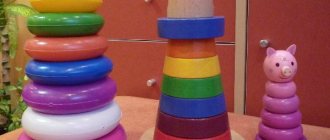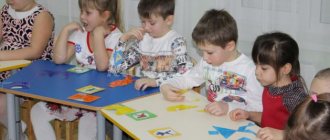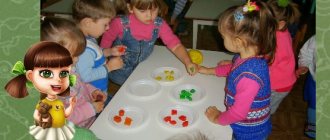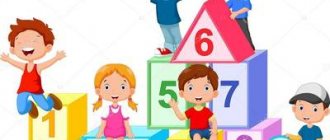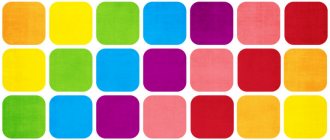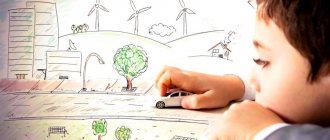Intellectual development of preschool children with the help of logical and mathematical games
Tatiana Afanasyeva
Intellectual development of preschool children with the help of logical and mathematical games
Effective development of the intellectual abilities of preschool children is one of the pressing problems of our time. Preschoolers with developed intelligence remember material faster, are more confident in their abilities, adapt more easily to a new environment, and are better prepared for school. The intellectual development of a preschool child is the most important component of his mental development . a special role in the development of a child’s intelligence , since the results of learning mathematics are not only knowledge, but also a certain style of thinking. Mathematics has enormous potential for developing children's thinking as they learn from a very early age. learning and development should be relaxed, carried out through a type of activity characteristic of this age - play. Knowledge given in an entertaining form, in the form of a game, is absorbed by children faster, more firmly, and easier than that which is associated with “soulless”
exercises.
The need for play and the desire to play in children must be used to direct in order to solve certain educational, educational and developmental tasks . Play is the main activity of preschool and is of great importance for intellectual development . The game helps us , teachers, to create motivation for children’s activities to enrich themselves, consolidate mathematical knowledge, and develop logical thinking . While working with children, I noticed that many children showed interest in entertaining games, but very few children showed persistence in completing the task. The first time they failed, they lost interest in the game . Relevance. (Slide)
At the present stage of modernization of preschool education, special attention is paid to the problem
of logical preschool age , which necessitates the search for ways and means of developing logical techniques of mental action, taking into account the needs and interests of preschool children .
Based on this, we can formulate the following hypothesis: logical and mathematical games and exercises play a major role in the development of intellectual abilities . (Slide)
The goal of the project: to create favorable conditions for the intellectual development of the child , for the transition from visual-effective thinking to figurative and elements of verbal-logical thinking . (slide)
Tasks:
- develop interest in solving cognitive, creative problems, in a variety of intellectual activities ;
- develop imaginative and logical thinking , the ability to perceive, display, compare, classify, modify;
— increase the ability to establish mathematical connections and patterns. (slide)
Effectiveness: the use of a system of work on the development of logical and mathematical concepts should help improve mathematical competence. (Slide)
When starting to develop a child and introduce him to the world of mathematics, we all probably want the child to do more than just “get ready for school”
, but really
became interested in mathematics and understood this science. To achieve success in this field, it is important to consider the following: the language of mathematics is the language of abstraction, logic , and symbol. In order to really understand this science, and subsequently learn to solve any intellectual problems , a child first of all needs to understand, and not memorize, what is being discussed.
For us, teachers, the search for alternative forms and methods of working with children is becoming urgent. Elementary mathematical concepts should not only provide the simplest knowledge and skills, but also, on their basis, develop thinking, imagination, ingenuity, and speed of reaction in preschoolers .
The mathematical development of preschool children is carried out through the joint activities of the teacher and children, as well as the cognitive and play activities of children. Mathematics in kindergarten should be entertaining and fun.
In my work I use educational games . This makes it possible to purposefully develop the child’s mental abilities, logic of thought , reasoning and action, flexibility of the thought process, ingenuity and ingenuity.
Created in group
, where a variety of didactic and
educational games and handouts are collected. (slide)
The children are happy to use the materials from the math center. (slide)
Embodying the idea of L. S. Vygotsky that only that training is good that “runs ahead”
forward of
the child's development , I tried to focus not on the level achieved by the children, but looking ahead a little, so that the children could make some effort to master the material. Intellectual work is not easy , and taking into account the age characteristics of children, I understand that the main method of development is problem-based and search and the main form of organizing children's activities is play. “play”
mathematics
with children But teaching mathematics is unthinkable without the use of entertaining tasks, games, and entertainment .
Children are very active in the perception of jokes, puzzles, and logical exercises . They persistently search for a solution that leads to a result. When an entertaining task is accessible to a child, he develops a positive emotional attitude towards it, which stimulates mental activity. The child is interested in the final goal : folding, finding the right shape, transforming. This goal captivates the child.
Of the variety of puzzles, the most acceptable are puzzles with counting sticks. They are called problems of ingenuity of a geometric nature, because during the solution, as a rule, there is a transformation of some figures into others, and not just a change in their number.
It is necessary to have sets of ordinary counting sticks in order to create visual puzzles from them. In addition, you will need diagrams with figures graphically depicted on them that are subject to transformation.
For example, from 5 counting sticks, add 2 equal triangles; out of 7 - 2 equal squares. (slide)
A special place among mathematical educational games is occupied by games for compiling planar images of objects, animals, birds, houses, ships from special sets of geometric figures. These sets represent parts of a figure cut in a certain way: a square, a circle, an oval. They are interesting to children and adults . Children are fascinated by the result: to create what they saw on a sample or what they had planned, and they are involved in active practical activities to select a way to arrange the figures in order to create a silhouette.
For example: this is the "Mongolian game"
,
“Columbus Egg”
,
“Tangram”
,
“Pythagoras”
.
(Slide)
I use these games both in direct educational activities and for children’s independent activities. Children love to play with games like "Petals"
,
“Fold a square”
,
“Cut teapots”
.
(Slide)
Of the variety of logical and mathematical games and entertainment, the most accessible and interesting are riddles and joke problems.
For example: “Two rings, two ends, and a stud in the middle.”
.
"Four brothers live under one roof"
.
I use them in the process of conversations, discussions, observations with children. In order to develop children's thinking, I use various types of logical problems and exercises . These are tasks to find a missing figure, to continue a series of figures, to search for patterns, numbers, to find a missing figure in a series. For example, which figure is extra here and why? What number should be put in the box? Game - “The fourth odd one”
(slide)
The purpose of logical tasks and exercises is to activate the mental activity of children, to revive the learning process. Games of ingenuity, puzzles, and entertaining tasks arouse great interest . Without being distracted, children can practice transforming figures for a long time, rearranging sticks or other objects according to a given pattern and their own design.
In my work on developing the logical and mathematical abilities of children, I use Dienesh's logic blocks . Why did I take the blocks? Because they contribute to the development of such mental operations as grouping objects by properties, eliminating unnecessary things, analysis, synthesis , children learn to prove and guess.
Playing with Dienesh's blocks arouses children's interest . This is how children, through play, quietly master complex mental operations and gain knowledge of elementary mathematical concepts.
Work with logical blocks can be carried out in all areas of activity:
1. Outdoor games (object references, designation of houses, paths, labyrinths.
2. Printed board games (making maps for the games “Settle the Tenants”
,
“What figure is missing”
,
“Find a place for the figure”
,
“Puzzles”
.
3. Role-playing games: “Shop”
(money is indicated by blocks, product prices are indicated by code cards)
.
Similar to : "Train"
,
"Mail"
.
The variety of games with Dienesh blocks makes it possible to use them at almost any moment, and also allows for an individual approach by simplifying or complicating tasks. (slide)
It is very important to note that the development of logical and mathematical intelligence in preschoolers is facilitated by the joint activities of parents and the child, and mandatory support in the family.
The teacher’s task is to inform parents about the whole variety of logical and mathematical games used in kindergarten, and to help create a developmental environment at home .
In my group, there is a mobile folder with game tasks, periodically I conduct consultations for parents, with the aim of orientation in the world of logical and mathematical games .
So, in my opinion, without the use of logical and mathematical games it is impossible to develop cognitive activity, logical thinking , memory, speech, creativity and other personal qualities. (Slide)
Their diversity and availability
help the teacher to successfully plan and implement assigned tasks, both in collective and individual work with children, which is the key to the successful intellectual development of a preschool child and, as a consequence, subsequent schooling.
Summary of an intellectual game in mathematics for children of the preparatory group of preschool educational institutions
Intellectual game “What?
Where? When?" in mathematics in kindergarten for older preschoolers Purpose: Generalization of children's knowledge of the material covered. Objectives: 1. Consolidate and justify answers to questions asked, knowledge about mathematical concepts. 2. Develop auditory and visual perception, curiosity, and communication skills. 3. To form the personal qualities of children: a sense of camaraderie, responsibility, empathy, mutual assistance, the ability to work in a team. 4. To instill in children an interest in activities and games, to induce an emotionally positive attitude, independence, goodwill, endurance, and the ability to listen to their comrades without interrupting them. Equipment: playing field, spinning top with an arrow, questions in envelopes, black box, individual sheets with tasks, pencils for each child; certificates, numbers, multimedia projector, video recording, markers, yellow tokens, globe. Preliminary work: Watching the game for preschoolers “What?
Where? When?”, conversation about the rules of the game, solving logical problems, addition and subtraction problems, measurement, asking riddles, games to develop attention and memory. Progress of the game:
Presenter: - Good afternoon, dear guests. Welcome to the intellectual game “What? Where? When?". Meet our experts. (The musical intro for the game “What, where, when?” sounds solemnly. Children enter the music room and line up in a semicircle in front of the game tables. Children read poetry. 1st child: Why is there solemnity around? Do you hear how quickly the speech stopped? to the queen of all sciences We begin this evening. 2nd child: It is no coincidence that she is given such honor. It is given to her to give answers. How to do a good calculation To build a building, a rocket 3rd child: There is a rumor about mathematics, That they put the mind in order , That's why people often say good words about her. Host: - Guys, look how many guests came to our intellectual game “What? Where? When?” to cheer for us. - Let's welcome our guests! (children clap) - We invite our teams take their places: 1 team “Planet of Knowledge”; 2 team “Knowledge”; 3 team “Math Patrol”; 4 team “Clever Guys”; 5 team of parents “Axiom”. Presenter: - Let me introduce you to our jury. Evaluate your game there will be parents (three people). Presenter: -And now, dear players, I will introduce you to the rules of the game: - you can discuss issues together with the whole team for 2 minutes; — the team captain or one of the players of this team, who is appointed by the team captain, can answer questions. — there should be silence in the hall during answers; — if the team is ready to answer ahead of time, it needs to raise its hand. — for violating the rules, the team receives a yellow warning sign; - for the correct answer - the team receives 1 point; Presenter: - Dear players! You must show erudition, intelligence and ingenuity, as well as be attentive and friendly in order to achieve victory. So we start the game. Host: Round 1! (The music “Gong, rotation of the top” sounds, the teacher rotates the top and moves the arrow to sector No. 1) Envelope No. 1 (the top has stopped) - Presenter: Attention to the screen! The middle school teacher plays with you. Let's watch the video question: -You have two drawings in front of you. You need to find ten differences between them and circle them. Presenter: -Teams, start the discussion. (2 min.) The discussion is over, announce the correct answer. Which team is ready to answer the question? Attention to the screen, correct answer. Host: Round 2! (The music “rotation of the top” sounds, the teacher rotates the top and moves the arrow to sector No. 2) Envelope No. 2 (the top has stopped) - Attention! Quick question! 1. Quick question for the Znayki team: “There are 8 people in the family: grandmother, grandfather, mother, father and children. How many children are there in the family? (4) 2. Quick question for the “Planet of Knowledge” team: “Chickens and dogs were walking in the yard. Misha counted their legs, it turned out to be 8. How many chickens were there, how many dogs?” (1 dog and 2 chickens) 3. Quick question for the “Math Patrol” team: “Alenka and Tanya have 4 candies each. Alena gave Tanya 2 candies. How many candies did each girl have? (2 and 6) 4. Quick question for the Smarties team: “How many ears do three mice have?” (6) 5. Quick question for the Axiom team: “There are 5 sons in the family. Each of them has one sister. How many children are there in the family? (6) Presenter: Round 3! (The music “rotation of the top” sounds, the teacher rotates the top and moves the arrow to sector No. 3 “Black box”) and the black box is brought in to the music. Attention, question: “He stands on one leg, spins and turns his head. He shows us countries, rivers, mountains, oceans” (Globe) Presenter: -Teams, start the discussion. -The discussion is over, announce the correct answer. -Which team is ready to answer the question? -Attention, correct answer. Host: Round 4! (The music “rotation of the top” sounds, the teacher rotates the top and moves the arrow to sector No. 4) Envelope No. 4 (the top has stopped) - Attention to the screen! Question from the teacher of the senior group (video recording) “Circle on the right only those geometric shapes from which the car is drawn.” Presenter: - Teams, start the discussion. — The discussion is over, announce the correct answer. — Which team is ready to answer the question? - Pay attention to the screen, correct answer. Host: Round 5! (The music “rotation of the top” sounds, the teacher rotates the top and moves the arrow to sector No. 5 “Treble Clef”) Envelope No. 5 (the top has stopped) Musical break (Musical physical education) Presenter: Round 6! (The music “rotation of the top” sounds, the teacher rotates the top and moves the arrow to sector No. 6) Envelope No. 6 (the top has stopped) - Attention, competition for captains: - Solve the examples and, using the letters next to the answer, decipher the word. 10-7= ... P 3+6= ... B 10-5= ... D 8-4= ... And Presenter: -Captains, begin the task. -Time is up, announce the correct answer. -Who is the first captain ready to answer the question? (if the team captain fails, the players help) -Attention to the screen, the correct answer. Host: Round 7! (The music “rotation of the top” sounds, the teacher rotates the top and moves the arrow to sector No. 7) Envelope No. 7 (the top has stopped) - Attention! Question from the teacher of the second junior group (video recording): “Here are mittens with examples. You need to solve the examples and use the answers to find a pair of each mitten” 3+4= … 9-2= 5+4= … 10-1= 3+3= … 8-2= 6+2= … 5+3= Presenter: — Teams, start discussing. — The discussion is over, announce the correct answer. — Which team is ready to answer the question? - Pay attention to the screen, correct answer. Host: Round 8! The music “rotation of the top” sounds, the teacher rotates the top and moves the arrow to sector No. Envelope No. 8 (the top has stopped) - Attention! Video question from a middle group teacher: “You have examples in front of you. Compare them using the signs >,< or =» 8-1 … 8+1 6+4 … 6+3 9-2 … 9-1 7+2 … 2+7 9+0 … 9-0 Presenter: - Teams , start the discussion. — The discussion is over, announce the correct answer. — Which team is ready to answer the question? - Pay attention to the screen, correct answer. Presenter: - Guys, our competition has come to the finals, we did our best! It's time to sum up the results and reward the smartest. While the jury sums up the results, listen to the poem Child: She teaches us to count and recognize figures. Explains numbers, signs, and how to solve problems! Know where is left and where is right Know the length and width. Understand the meaning: “equal”, “more”, “less”, height. Presenter: -And now we give the floor to our distinguished jury! The jury announces its decision and presents certificates to the teams. Presenter: - Well done! We congratulate you! -Experts, what do you remember most about the game today? -Did you like being experts? Thank you for an interesting game, and we will meet at the game next season. (Music "Final")
The music “rotation of the top” sounds, the teacher rotates the top and moves the arrow to sector No. Envelope No. 8 (the top has stopped) - Attention! Video question from a middle group teacher: “You have examples in front of you. Compare them using the signs >,< or =» 8-1 … 8+1 6+4 … 6+3 9-2 … 9-1 7+2 … 2+7 9+0 … 9-0 Presenter: - Teams , start the discussion. — The discussion is over, announce the correct answer. — Which team is ready to answer the question? - Pay attention to the screen, correct answer. Presenter: - Guys, our competition has come to the finals, we did our best! It's time to sum up the results and reward the smartest. While the jury sums up the results, listen to the poem Child: She teaches us to count and recognize figures. Explains numbers, signs, and how to solve problems! Know where is left and where is right Know the length and width. Understand the meaning: “equal”, “more”, “less”, height. Presenter: -And now we give the floor to our distinguished jury! The jury announces its decision and presents certificates to the teams. Presenter: - Well done! We congratulate you! -Experts, what do you remember most about the game today? -Did you like being experts? Thank you for an interesting game, and we will meet at the game next season. (Music "Final")
We recommend watching:
Mathematical dominoes for preschool children 5 - 7 years old Didactic game with your own hands for preschoolers from 4 years old to develop logical thinking Mathematical KVN in kindergarten for older preschoolers Quest game on FEMP on the topic “Signs of Spring” in the preparatory group of a preschool educational institution
Similar articles:
Mathematical role-playing game for children of the preparatory group
Mathematical fairy tale for children 5-7 years old
